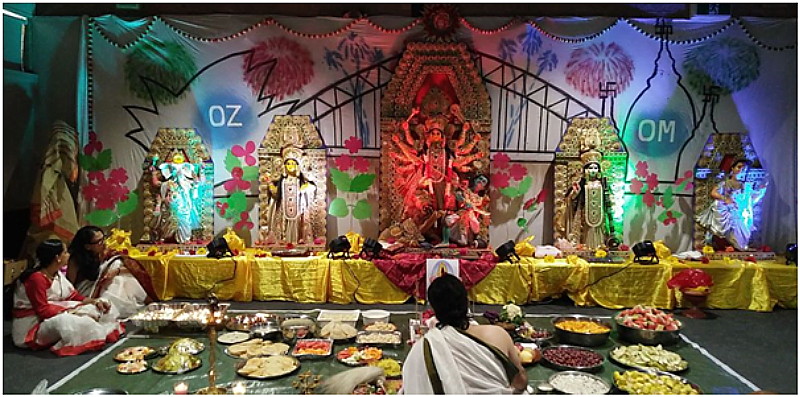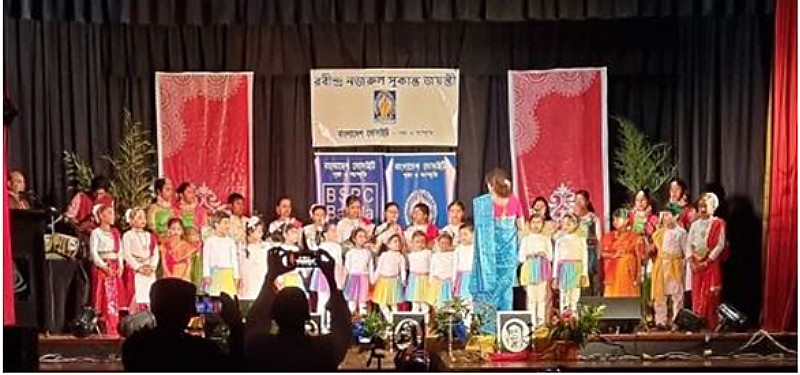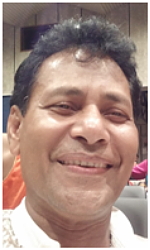 Bangla outside Bangladesh: Zooming in on my rearview mirror Dr Swapan Paul
The purpose of my storytelling, however, is not to eulogise Nazrul Bhai but to zoom in on a few areas of my involvement in the socio-cultural aspects of the Bangladeshi immigrants in Australia, with a particular emphasis on my exposure and experience in Sydney. I specifically mentioned his name as he has inspired me to get involved in works that benefit my community. Talking of immigration or even touring an English-speaking country by any Bangla-speaking individual is less than a 200-year-old story. The very first Bengalee who visited the United Kingdom, an English-speaking nation, was Raja Ram Mohon Roy in 1831. Six decades later, Swami Vivekananda toured the USA in 1893 and delivered his historic speech in Chicago on the 11th of September that very year. He also returned to the undivided India, which paved the way for Bangalees to tour and immigrate to such countries. And the rest is history. Now, more than fifteen (15) million Bangladeshis reside outside Bangladesh. This number is the account of just twenty (20) countries. If the rest are counted, it will be more than twenty (20) million. That number makes up about 10% of the total population in Bangladesh, which is the top-most proportion of any nation. Add to that another ten million Bengalee people from India who live outside their home country; we are talking about thirty (30) million Bengalee people living outside their homelands. By the above comparison, there were few immigrants from Bangladesh origin to Australia until the mid-1990s, when a new wave of migration occurred in Australia. Among those immigrants, there were many graduates from one university in Bangladesh - the Bangladesh Agricultural University. I happen to be one of those people, a graduate of aquatic sciences and fisheries. I immigrated to Australia in 1995 with my wife, Dr Nilima Paul, an academic in Australia. And from the very second month of my arrival, I became involved in community activities. Getting involved with community activities in Sydney was not a shock or surprise because I was involved with positive politics during my university life in Bangladesh. I will not be telling those past stories here. However, I will be narrating a handful of my significant involvement in promoting, practising, and expanding Bangla tradition and culture in Australia, including the language. As I go further into this, I will start with this disclaimer that I have a general faith in the Hindu Religion. However, I am a genuinely secular individual who loves Bangladesh and who sincerely believes in the independence of the country, including a firm belief that should Bangladesh remain a genuinely secular and scientifically innovative nation – it will surpass many other fast-developing nations in economic and social development within the near future. I believe this because the Bengalee people, an ethnolinguistic hybrid South-Asian group, have the quality and capability to achieve that goal. In addition, the geographic region is the most fertile of all lands on this earth; it is the Sonar Bangla or Golden Bengal, described by Poet Rabindranath Tagore, the first Bengali to win the prestigious Nobel Prize.  My very first involvement was with an informal group of Bangladeshi Hindu people in Sydney, who organised the first Durga Puja festival by any Bangladeshi group in Australia. And that began a new era of cultural practices by a Bangladeshi community group in Australia. I was assigned a task of my passion for decorating the Puja Mondop. I have happily embraced this with mixed feelings. I knew I would not be able to decorate it the way I would have liked, but having the opportunity to do so in a cultural landscape utterly different from Bangladesh was an amazing experience. Since then, there has not been a single Puja Mondop within my group, the Bangladesh Society for Puja & Culture Inc (BSPC), where I have not been leading the decoration. In doing so, I involve the new generation from the Bangladeshi diaspora to actively transfer some traditions and slowly develop some appreciation for various Bangla cultures and traditions. One of the Captain Cooks, Mr. Mrinalendu Shekhar Dey, was elected as the first President of BSPC. As part of this journey, the international competition organised by the West Bengal Government of India under the Sharod Somman banner, BSPC decoration, won a trophy and cash prize. This recognition is a tremendous inspiration for continuing cultural practices in this multicultural land. It may also be worthwhile to mention that the NSW Art Gallery has once organised the making of the Durga Protima at the Art Gallery itself and staged the Durga Puja, with an understanding that there is no other such example of the annual making of art forms, then worshipping, followed by drowning in water and rebuilding in the following year altogether again! They saw it as a unique living culture and tradition, hence this testimony! I would also like to add one of my close observations concerning the puja festivities in Sydney; I notice that the very tradition and culture of the Sarbojonin (universal) flavour of Durga Puja is also present here. Irrespective of one's faith in a religion, all are welcome to the Puja; I see many people, regardless of their faiths, attending these festivities like they would have done back in Bangladesh. This sense of Sarbojonin touch is unique and being upheld here in Australia. This is an essential aspect of our brotherhood to keep celebrating with others. With time, the Bangladeshi diaspora in this new home outside our native country will regain and strengthen the mutual tolerance and harmony between communities, which has been experiencing a gradual but sad decline in our homeland. Even the dignitaries from the Bangladesh High Commission in Canberra or the Consulate office in Sydney represent the Government of Bangladesh in these festivities and strengthen the message of harmony and brotherhood, signalling a fabulous initiative and overture. I would also like to touch on another critical community issue: the Bangla language practices in this land of English-speaking people. Some months after I arrived, I became involved in promoting the Bangla language among the upcoming generations. Soon, we formed the Bangla Prosar Committee (BPC). At about the same time, I also became involved with the Ekushe Boimela Porishod. The BPC was formed in conjunction with Engineer Bimal Maity, a Bengalee from West Bengal, who dedicated himself to the cause of promoting Bangla as a language. I quickly joined BPC and Mr Bimal Maity and succeeded in initiating Bangla classes at a public school in Ashfield. A few years later, it was included as a language under the NSW Government’s Saturday School of Community Languages program. This has continued, and at the same time, the Bangla language has been taught in eight (8) public schools in NSW during regular school terms. These are small yet significant milestones achieved by the Bangla-speaking people in NSW. At one stage, I became the President of BPC, which was when the language initiative was almost closing due to the lack of interested students. However, with renewed community engagement, these schools have been still running. I must mention here that this revival was arduous work and required doorknocking to dozens of families in Sydney. In the process, we developed a curriculum, which the NSW Government adopted. From my recollection, Dr Mohammed Abdur Razzaque, a professor at the University of New South Wales UNSW, drafted that curriculum. He also edited a Bengali book for the young Bengali students. Such was the collective spirit and contributions of the Bangalee in Sydney. However, we have not succeeded in introducing Bangla as an additional language at HSC. Achieving this objective requires a minimum number of ongoing students who will appear at the HSC taking Bangla. However, we have not yet reached this threshold. We could not accomplish this because many Bengalee parents seem ambivalent about the benefits of learning the Bangla language in English-speaking Australia. They never tried to understand the real benefits, the most notable one being a student's ability to add extra scores, giving the student an advantage over others to secure a better admission. Parents' ambivalence and disinterest in this issue have been a painful lost opportunity for the ethnic Bengalee community. The other group that I have been associated with and actively involved in, Ekushe Boimela Porishad, was the brainchild of Mr Nehal Neyamul Bari, the founder of this Porishod. Initially, the Porishod's primary task was arranging book stalls for selling Bengali books at various events organised by the Bengali-speaking community in Sydney. Later, it took the initiative to organise a Book Fair (Boi Mela) emulating Dhaka's Annual Bangla Academy Boimela. It became the vanguard promoting Mother Languages in Australia within a short time. Hence, it has adopted 'Conserve Your Mother Language' as its slogan. As its scope expanded, the Porishod was renamed Ekushe Academy Australia (EAA) to broaden its reach outside just organising the Book Fair. EAA had a dream to establish the world's first Mother Language Monument, and it succeeded in achieving that dream in 2006 with the help of the Bangladesh Government and the Bangladeshi diaspora in Sydney. This Monument has stood upright in the Ashfield Park since 2006. I feel so privileged and proud to have been involved with EAA when we made decisions about the Monument and when we unveiled it for all Sydneysiders and visitors. The current Prime Minister of Australia, Hon Anthony Albanese MP, was a staunch supporter of the Monument initiative and was present at the time of the inauguration. The sweetest feeling has been the unveiling part of the Monument, which I planned and executed. This occasion enabled me to apply my imagination and intellect in public. At the time, Mr. Nirmal Paul was the President of EAA. However, due to some irreconcilable differences involving policy issues about EAA, Mr Paul opted to quit the organisation the following year and form the Mother Language Conservation Movement International. Experiencing and accepting such differences in accomplishing community objectives have shaped our community in a new world we chose to adopt as our new home. In whatever way we may like to explain our differences (or similarities) on various issues facing the community, I have learnt that community involvement requires an enhanced tolerance level and acceptance of contrary views and ideas. Having worked in the community for over 25 years in many roles, capacities, forms, and shapes, I view this as a wasteful and counterproductive practice inhibiting the community's progress and prosperity. My experiences with community work taught me the virtues of listening to all views and ideas and discussing them in a democratic and respectful environment so that our decisions are collective and contextual. We must constantly remind ourselves to work within this land's legal and societal frameworks to develop a healthy Bangladeshi diaspora in Australia.  Along the same line of promoting and practising the Bangla language, I also associated myself with another Bangla school initiative: the BSPC Bangla School, managed by the Bangladesh Society for Puja and Culture in Sydney. BSPC initiated the Bangla school in 2002, mainly for students from the inner-west and western suburbs of Sydney. This school is going well, and it is gaining strength to strength. In addition to offering Bangla language classes, this school also offers lessons in art, music, dance, and musical instruments such as Tabla and Harmonium. Many students attend the school every Sunday during school term. Since the government of NSW has been supporting this programme for many years, this is a government-sponsored initiative under its Community Language Initiative. A local public school has been providing us with six classrooms to run these classes. All these exemplify that the NSW government has been genuinely trying to promote various languages to enhance cultural traditions in New South Wales. One remarkable aspect of teaching Bangla language and culture in this school is the broad, secular perspective rather than any specific religion-based initiative. That is how the students from the school perform at the Robindra-Nazrul-Sukanta Jayanti event that BSPC has organised. Only BSPC has been organising this secular event in Sydney for the longest of years. As a Bangladeshi immigrant in Australia, I feel happy that I have been able to contribute to yet another sector that focuses on protecting, conserving, and enhancing the rapidly deteriorating environment of Bangladesh. Bangladesh, a highly populated country, has limited land available to grow the necessary food for its people. Supplying protein, particularly fish protein, ensuring that its riverine and wetland ecosystems are thriving, providing people assistance in living a healthy life, and securing proper education for its population put Bangladesh at several crossroads. While meeting all these challenges is necessary, it is tough and requires innovative thinking. From the realisation that Bangladesh’s environment was fast deteriorating, in 1998 in New York, Prof Nazrul Islam, a Harvard Economist, started what is now known as the Bangladesh Environment Network (BEN). Following his footprints, we initiated BEN in Australia in 2001 by organising a conference. I have been the local convener, with Mr Kamrul Ahsan Khan being the Country Coordinator. BEN’s initiative is significant, and it is pleasing to see many Bangladesh diaspora supporting it. BEN has made a difference in Bangladesh, mainly through the local group, BAPA (Bangladesh Poribesh Andolon). Phasing out of the 2-stroke engines from the cities, river restoration, Haor-Baor-Beel protection, forest conservation, sustainable energy, less reliance on coal and embracing renewables – all these have been due to the push from BEN and BAPA. Here in Australia, we have created awareness and participated in the Clean-up Australia Day campaign. That is how, after 20 years of continuous involvement, we have been awarded the Environmental Citizen of the Year accolade in 2018. I am doubtful if the diaspora of any other nation has done as much as we, the Bangladeshi diaspora, have done! Although Bangladesh is a relatively new nation, our deep bond with the country makes us exceptional citizens. We, the Bangladesh diaspora in Australia, have made ourselves distinctively visible by being involved in several socio-cultural-environmental issues. Out of more than 172 nations that have their fellow citizens as immigrants in Australia, the immigrants from Bangladesh have made substantial contributions to many aspects of the nation-building activities in Australia. Be in academia, accounts and finance sector, IT, environmental science, agriculture, quarantine, business and trade, health services, food and beverages, local politics and many more: the people of Bangladesh origin have steadily marched along the mainstream Australian people. I feel proud to be part of this journey. However, at the same time, I remain nervous that unless we, the ‘first fleet diaspora', lay a positive and constructive foundation for the many more generations yet to call Australia home, the rapid progress and visibility that we have been able to make could fade away. I sincerely hope that we build many cohorts of future leadership who will help uphold the Bangladeshi flag and make Bangalee a proud ethno-linguistic identity of its own. |



